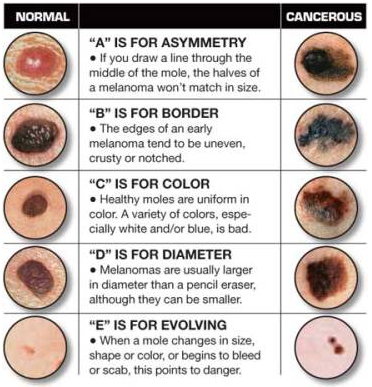The “C” word is a bad word anywhere you go. No one wants to hear they, or their loved ones, have cancer. Having cancer doesn’t just do something to you physically, it does something to you mentally as well. Skin cancer, however, has been one of the leading forms of cancer over the last 10 years and it is a very dangerous form of cancer. It can first appear as a simple growth, or an accumulation of cells if you wanted to break it down that way. You might have noticed a sore or something that looks like a pimple that doesn’t go away. At first it is painless, but once it gets rooted in you, it’s one of the most dangerous things that your body will experience. At that point, not even a biopsy to remove the mole or pimple can be enough to stop the spread of the cancer. (But it can if it is caught early enough.)

Some symptoms of skin cancer are:
- New growth on skin (be sure to do a full body check to see if this is the case)
- Sore that doesn’t heal or changes shape frequently
- Existing skin growth
Keep in mind, though, that not every symptom on the skin is skin cancer. Some of that can come in the form of moles that can be easily removed. In any case, however, it is still vital for your health to get it checked out by a doctor.
Normally, the skin cancer will start with the areas on the body that are exposed most to the sun. Primarily your face, chest, neck and back are the most targeted. High levels of sun exposure reach these areas daily but you want to make sure you guard them once in a while, too.
Some Things to Look for
- Simply be aware of your body and the growths that enlarge. If that growth oozes fluids (some of the fluids can smell rough) or blood, that’s a cause for concern. Seeking medical attention quickly is the best way to go.
- Skin spots. A good rule of thumb is that skin spots should be no larger than the length of a pencil eraser from edge to edge. Also, be aware of the color. It’s one thing if it maintains a certain color, but it’s another if there are variations of color in it.
- Check the borders of your mole. The borders tell an intriguing story. In fact, it is so telling that there are instances where it is obvious that it’s skin cancer. If you look at the asymmetry of the mole, you have to be aware that it should be symmetrical for a reason. That’s the way the body is designed.
Skin cancer can spread slowly, or it can spread like wildfire. It doesn’t matter how in shape we are in this regard it can still spread so quickly that you won’t even realize it until it’s too late. Skin cancer symptoms are not fun to deal with because it can mount a lot of stress and pressure on anyone. There are some ways to remove skin cancer such as freezing the tissue, laser therapy, excisional therapy, radiation, or chemotherapy.
Depending on how deep or far the cancer has spread will determine the type of treatment. There are options, however, for people that have cancer. Ultimately, though, the best thing to do is prevent skin cancer from even forming.
Prevention
There are ways to prevent skin cancer that we can easily implement into our daily lives. When we neglect our bodies bad things will happen – skin cancer is one of the cancers that no one wants to deal with because it’s deep rooted ways into your body. It can cause a lot of havoc in a very fast amount of time.
- Stay out of exposure of the sun for long periods of time if you don’t have sunblock. Sun block works; it’s just a matter of applying it right. The UV rays are especially dangerous to your cells and it can reflect off water, stainless steel items, sand, and virtually any shiny object.
- If you do stay in the sun for long periods of time, be sure to cool down quickly. Drink plenty of water and make sure that you don’t get burned too badly. Sunburns once in awhile are okay, but excessive tanning is bad (even the unnatural tanning).
- Wear a hat or something that has a brim. This will at the very least shield some parts of your body from exposure to UV rays.
Of course it’s going to be impossible to not completely be affected from the sun. It’s natural and you’ll touch it just about every day of your life. But you can be careful when you’re out there so you don’t have to endure a lot of future problems.
[toggle title=”Featured images”]
 License: Image author owned
License: Image author owned
[/toggle]
Donna Shannonis an oncologist practicing in Sioux Falls. She highly recommends finding out what the skin cancer symptoms are so you can take precautions and know what to look for.

Leave a Reply